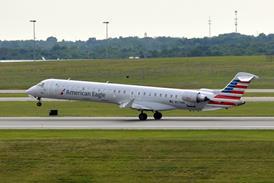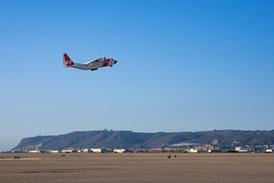GUY NORRIS / LOS ANGELES
GE, P&W and R-R to study new powerplant designs rather than develop 777 derivatives
Boeing has asked General Electric, Pratt & Whitney and Rolls-Royce to study new powerplant designs for the Sonic Cruiser, rather than develop simple 777-style derivatives as originally intended.
The change comes after initial windtunnel tests, further computational fluid design work, customer studies and evaluation of emissions and performance requirements, says Boeing. Sonic cruiser programme marketing vice-president John Roundhill says the results "argue for a major change, if not a brand new engine".
The chief reason for dropping the derivative engine route was core size, says Roundhill. Although core size is normally set by top of climb thrust requirements, the Sonic Cruiser's higher altitude thrust needs, added to rigorous emissions and noise targets, presented difficult challenges. "This aircraft has a different relationship of climb thrust to take-off thrust and we found the optimal core size was smaller than the 777," he says.

In response to Boeing's redirection, engine makers are presenting outline solutions that attempt to combine the low-pressure spool performance characteristics of the largest 777 engine, the GE GE90-115B, with the cruise condition performance of the standard 777-200ER/300 engines. "We gave them some explicit criteria in terms of inlet diameter because of drag, and exhaust velocity because of noise. The results showed us we required a new engine," he says.
As a result, the baseline Sonic Cruiser is being refined around the new notional engine. This calls for 90,000lb-class (400kN) take-off thrust for a 3,200m (10,500ft) runway roll at maximum weight. "However, if you look at the top-of-climb thrust and did a typical lapse rate analysis, the take-off rating would be 100,000lb [45,400kg] plus, so that's why this is different," explains Roundhill. Despite changes to the core and low pressure system he adds that "it looks like we can meet the requirements with an engine that still fits in the geometry of the baseline design".
Boeing plans to complete refining the baseline airframe design with the engine makers by February or March. Derivatives of the basic engine will be offered on the two major Sonic Cruiser options being discussed with the airlines. These are a 200-seater with a 3,900km (7,500nm) range, and a 240-250 seater capable of 12,025km plus. Cruise speed is still pegged towards the upper end of the Mach 0.95 to 0.98 range. The minor leap to Mach 1.02, described as the "other" Sonic Cruiser aerodynamic "sweet spot" would "require a bigger engine because of the higher drag, so we'll continue to think about that", adds Roundhill.
Roundhill says the vertical tails have "moved outboard and forward a bit" as a result of the latest windtunnel tests. These revealed potential interference issues from the canard wake, which increases control-power needs.
Source: Flight International























